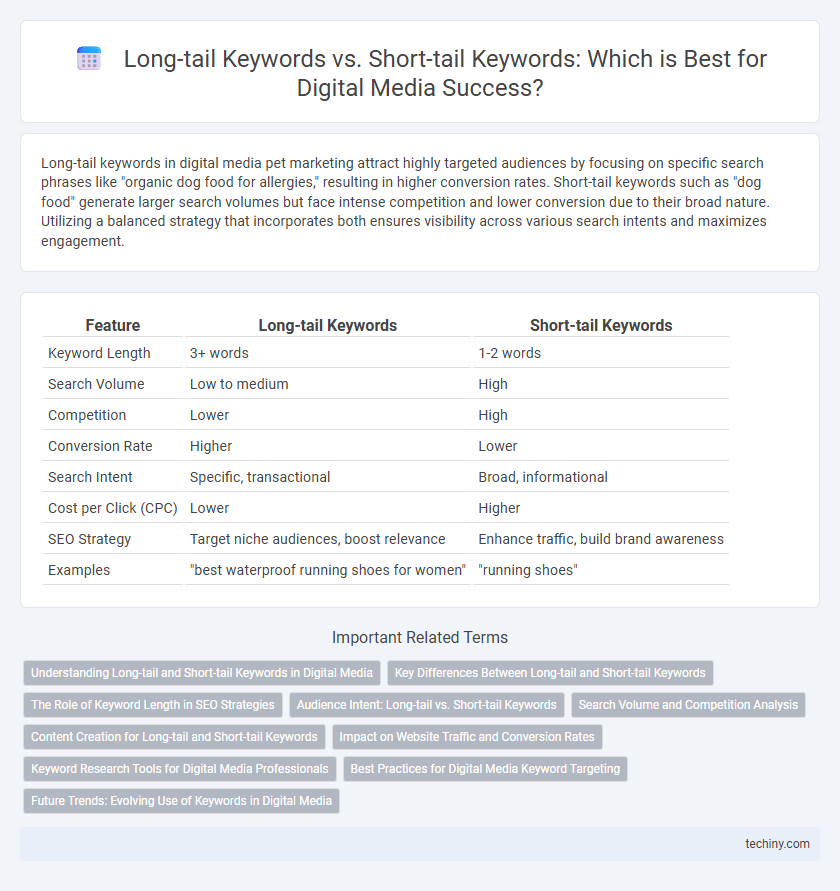Long-tail keywords in digital media pet marketing attract highly targeted audiences by focusing on specific search phrases like "organic dog food for allergies," resulting in higher conversion rates. Short-tail keywords such as "dog food" generate larger search volumes but face intense competition and lower conversion due to their broad nature. Utilizing a balanced strategy that incorporates both ensures visibility across various search intents and maximizes engagement.
Table of Comparison
| Feature | Long-tail Keywords | Short-tail Keywords |
|---|---|---|
| Keyword Length | 3+ words | 1-2 words |
| Search Volume | Low to medium | High |
| Competition | Lower | High |
| Conversion Rate | Higher | Lower |
| Search Intent | Specific, transactional | Broad, informational |
| Cost per Click (CPC) | Lower | Higher |
| SEO Strategy | Target niche audiences, boost relevance | Enhance traffic, build brand awareness |
| Examples | "best waterproof running shoes for women" | "running shoes" |
Understanding Long-tail and Short-tail Keywords in Digital Media
Long-tail keywords consist of longer, more specific phrases that attract highly targeted audiences with lower competition, ideal for niche content in digital media campaigns. Short-tail keywords are broader, higher-volume search terms that drive large traffic but face intense competition, often resulting in less qualified leads. Effective digital media strategies balance both types to optimize visibility and engagement across diverse user intents.
Key Differences Between Long-tail and Short-tail Keywords
Long-tail keywords consist of longer and more specific search phrases, often generating lower search volume but higher conversion rates due to targeted intent, while short-tail keywords are broad, high-volume terms with greater competition and lower precision. Long-tail keywords help digital marketers capture niche audiences and improve SEO efforts by addressing detailed queries, whereas short-tail keywords drive general traffic but may result in lower engagement. Optimizing content with a balanced mix of both keyword types enhances search engine visibility and maximizes user acquisition strategies.
The Role of Keyword Length in SEO Strategies
Long-tail keywords, typically containing three or more words, target highly specific user intents, resulting in lower competition and higher conversion rates for digital media campaigns. Short-tail keywords, usually consisting of one to two words, attract broader audiences but face intense competition, making them less efficient for niche targeting in SEO strategies. Balancing keyword length by integrating both long-tail and short-tail keywords enhances overall search visibility and drives relevant traffic in digital media marketing.
Audience Intent: Long-tail vs. Short-tail Keywords
Long-tail keywords capture specific audience intent, often reflecting detailed search queries with higher conversion potential in digital media campaigns. Short-tail keywords attract broader traffic but tend to have higher competition and lower conversion rates due to their generic nature. Understanding audience intent through keyword analysis enables targeted content strategies that improve engagement and ROI.
Search Volume and Competition Analysis
Long-tail keywords typically have lower search volume but significantly less competition, making them ideal for targeting niche audiences and achieving higher conversion rates in digital media campaigns. Short-tail keywords attract high search volume but face intense competition, often leading to higher costs per click and reduced visibility for smaller businesses. Analyzing search volume alongside competition metrics allows marketers to strategically balance keyword selection for optimal search engine rankings and budget efficiency.
Content Creation for Long-tail and Short-tail Keywords
Long-tail keywords in digital media content creation generate highly targeted traffic by addressing specific user intents, resulting in better engagement and higher conversion rates. Short-tail keywords, while broader and more competitive, are essential for gaining initial visibility and driving substantial traffic volume. Balancing both keyword types enables content creators to optimize reach and relevance across different audience segments.
Impact on Website Traffic and Conversion Rates
Long-tail keywords generate highly targeted website traffic by capturing specific search intents, resulting in higher conversion rates due to their relevance and lower competition. Short-tail keywords attract a broader audience but often face intense competition, leading to higher traffic volume with lower conversion rates. Balancing both strategies optimizes overall website performance by combining wide reach with precision targeting.
Keyword Research Tools for Digital Media Professionals
Long-tail keywords generate higher conversion rates by targeting specific search intent, whereas short-tail keywords bring higher search volume but increased competition. Digital media professionals leverage keyword research tools like Ahrefs, SEMrush, and Google Keyword Planner to analyze search trends, keyword difficulty, and user intent, enabling optimized content strategies. Integrating both long-tail and short-tail keyword data enhances visibility and drives targeted traffic for digital media campaigns.
Best Practices for Digital Media Keyword Targeting
Long-tail keywords drive higher conversion rates in digital media campaigns due to their specificity and alignment with user intent, making them essential for targeted audience engagement. Short-tail keywords generate broader visibility but often suffer from higher competition and lower click-through rates, so balancing both with a focus on long-tail keywords enhances search engine optimization and paid media performance. Leveraging keyword research tools like Google Keyword Planner and SEMrush helps identify relevant long-tail phrases while optimizing short-tail keywords for brand awareness and volume.
Future Trends: Evolving Use of Keywords in Digital Media
Long-tail keywords are gaining prominence in digital media for their ability to target highly specific audience segments, leading to higher conversion rates and enhanced user engagement. Short-tail keywords remain important for broad visibility but face increasing competition and decreasing click-through rates due to their generic nature. Future trends indicate a shift toward AI-driven keyword optimization that leverages natural language processing to identify nuanced long-tail phrases, aligning content more closely with evolving user search intent and voice search patterns.
Long-tail Keywords vs Short-tail Keywords Infographic

 techiny.com
techiny.com